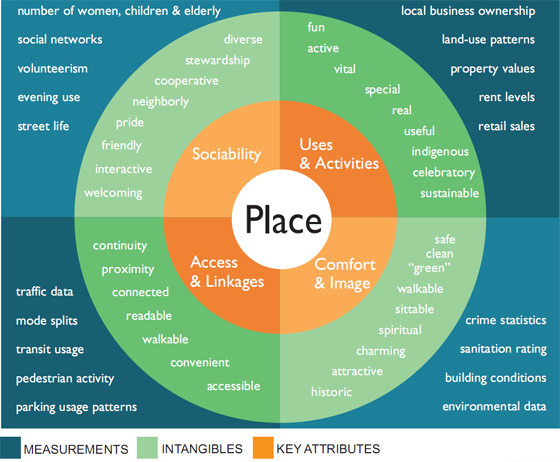 Four key qualities of a successful place
Four key qualities of a successful place
Access and linkages
Access concerns how well a place is connected to its surroundings both visually and physically. A successful public space is visible, easy to get to and around. Physical elements can affect access (a continuous row of shops along a street is more interesting and generally safer to walk by than a blank wall or empty lot), as can perceptions (the ability to see a public space from a distance). Accessible public places have a high turnover in parking and, ideally, convenient public transit.
Comfort and image
Comfort and image are key to whether a place will be used. Perceptions about safety and cleanliness, the context of adjacent buildings, and a place's character or charm are often foremost in people's minds—as are more tangible issues such as having a comfortable place to sit. The importance of people having the choice to sit where they want is generally underestimated.
Uses and activities
Activities that occur in a place—friendly social interactions, free public concerts, community art shows, and more—are its basic building blocks: they are the reasons why people come in the first place and why they return. Activities also make a place special or unique, which, in turn, may help generate community pride.
Sociability
This is a difficult but unmistakable quality for a place to achieve. When people see friends, meet and greet their neighbors, and feel comfortable interacting with strangers, they tend to feel a stronger sense of place or attachment to their community—and to the place that fosters these types of social activities.
Place Diagram
In evaluating thousands of public spaces around the world, PPS has found successful places have four key qualities in common: they are accessible; people are engaged in activities there; the space is comfortable and has a good image; and, finally, it is a sociable place—one where people meet each other and take people when they come to visit. PPS developed the Place Diagram as a tool to help people in judging any place, good or bad:

Imagine the center circle on the diagram is a specific place that you know: a street corner, playground, or plaza outside a building. You can evaluate that place according to four criteria in the orange ring. In the green ring are a number of intuitive or qualitative aspects by which to judge a place; the blue area shows the quantitative aspects that can be measured by statistics or research.
High proportion of people in groups
The presence of people in groups can be an index of selectivity. William H. Whyte's Street Life Project found that often when people go to a plaza in twos or threes, and always when they rendezvous there, it is because they have decided to do so in advance.
Higher than average proportion of women
Women tend to be more discriminating about the spaces they use. Reasons for this range from types of seating available in a place to perceptions about whether a place is safe.
Different ages
The presence of people at a range of ages usually means a place has different constituencies who use it at different times of day. For example, pre-school age children and their guardians can use a neighborhood park when others are working, as can seniors and retirees.
Varied activities
Popular places generally have more things to do than less successful spaces. One of the most successful public places PPS has evaluated is the town dock in Cold Spring, NY. PPS staff and community members counted as many as 20 different activities occurring simultaneously, ranging from fishing to feeding ducks to picnicking, rowing, and swimming. Many of these activities don't require special equipment or facilities.
Affection
There is generally more smiling, kissing, embracing, holding and shaking of hands, and so forth in good public places than in those that are problematic.







